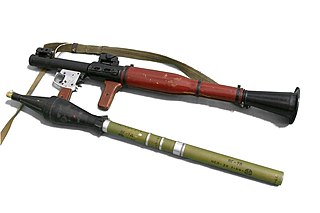
A rocket-propelled grenade (RPG) is a shoulder-fired rocket weapon that launches rockets equipped with an explosive warhead. Most RPGs can be carried by an individual soldier, and are frequently used as anti-tank weapons. These warheads are affixed to a rocket motor which propels the RPG towards the target and they are stabilized in flight with fins. Some types of RPG are reloadable with new rocket-propelled grenades, while others are single-use. RPGs are generally loaded from the front.

High-explosive anti-tank (HEAT) is the effect of a shaped charge explosive that uses the Munroe effect to penetrate heavy armor. The warhead functions by having an explosive charge collapse a metal liner inside the warhead into a high-velocity shaped charge jet; this is capable of penetrating armor steel to a depth of seven or more times the diameter of the charge. The shaped charge jet armor penetration effect is purely kinetic in nature; the round has no explosive or incendiary effect on the armor.

The Panzerfaust was a development family of single-shot man-portable anti-tank systems developed by Nazi Germany during World War II. The weapons were the first single-use light anti-tank weapons based on a pre-loaded disposable launch tube, a weapon configuration which is still used today.
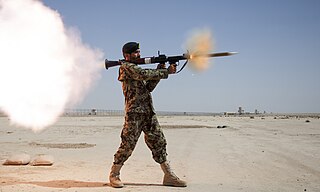
Shoulder-fired missile, shoulder-launched missile or man-portable missile, among other variants, are common slang-terms to describe high-caliber shoulder-mounted weapons systems – that is: weapons firing large heavy projectiles ("missiles"), typically using the backblast principle, which are small enough to be carried by a single person and fired while held on one's shoulder. The word "missile" in this context is used in its original broad sense of a heavy projectile, and encompasses all shells and rockets, guided or unguided. A more formal variant is simply shoulder-fired weapons system and the like.

The RPG-7 is a portable, reusable, unguided, shoulder-launched, anti-tank, rocket launcher. The RPG-7 and its predecessor, the RPG-2, were designed by the Soviet Union, and are now manufactured by the Russian company Bazalt. The weapon has the GRAU index 6G3.

The M72 LAW is a portable one-shot 66 mm (2.6 in) unguided anti-tank weapon. The solid rocket propulsion unit was developed in the newly-formed Rohm and Haas research laboratory at Redstone Arsenal in 1959, and the full system was designed by Paul V. Choate, Charles B. Weeks, Frank A. Spinale, et al. at the Hesse-Eastern Division of Norris Thermador. American production of the weapon began by Hesse-Eastern in 1963, and was terminated by 1983; currently it is produced by Nammo Raufoss AS in Norway and their subsidiary, Nammo Defense Systems in Arizona.

The RPG-29 "Vampir" is a Soviet reusable rocket-propelled grenade (RPG) launcher. Adopted by the Soviet Army in 1989, it was the last RPG to be adopted by the Soviet military before the fall of the Soviet Union in 1991.
The RPG-27 is a Soviet single shot disposable rocket-propelled grenade (RPG) shoulder-fired missile and rocket launcher. It entered service with the Soviet Army in 1989.
The Panzerfaust 3 is a modern semi-disposable recoilless anti-tank weapon, which was developed between 1978 and 1985 and first entered service with the Bundeswehr in 1987. It was first ordered in 1973 to provide West German infantry with an effective weapon against contemporary Soviet armor, thereby replacing West Germany's aging PzF 44 Light Lanze launchers and the heavy Carl Gustaf 84 mm anti-tank recoilless rifle manufactured in Sweden.
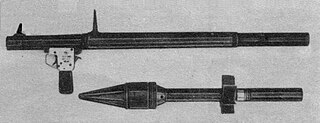
The RPG-2 is a man-portable, shoulder-fired anti-tank weapon that was designed in the Soviet Union. It was the first successful anti-tank weapon of its type, being a successor to the earlier and unsuccessful rocket-propelled grenade RPG-1.
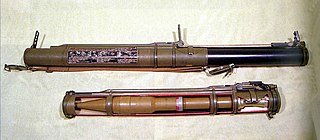
The RPG-18 Mukha is a Soviet short-range, disposable light anti-tank rocket launcher designed in 1972. It was based on the M72 LAW.
The RPG-16 is a handheld anti-tank grenade launcher for anti-tank warfare. It was developed in 1968 and adopted by the Soviet Army in 1970 for special operation teams and the Soviet airborne troops (VDV). These were deployed during the Soviet–Afghan War (1979–1989) and saw service during several battles in that conflict.

The Type 69 85mm RPG, made by Norinco, is a Chinese variant of the Soviet RPG-7. First introduced in 1972, the Type 69 is a common individual anti-tank weapon in service with the PLA. More advanced grenade rounds were developed in the 1980s and 1990s to meet the requirements of modern battlefields. Eventually, the aging Type 69 RPG family was replaced by more modern anti-tank weapon systems developed by China such as the Type 89 and Type 08.

The PF-89 or Type 89 is a portable, disposable, unguided, shoulder-launched, anti-tank rocket-propelled rocket launcher. Developed by Norinco for People's Liberation Army, PF-89 was designed to replace the obsolete Type 69 RPG, providing a man-portable, single-use assault weapon system that could be used mainly by infantry squads to engage and defeat light armor and bunkers.
Bulgaria is a NATO member country with a large indigenous defence industry. Most of its weaponry is of Soviet design, but with significantly improved performance. Bulgaria is ranked as a "medium" small arms exporter according to the Small Arms Survey.
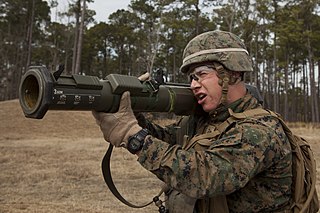
The AT4 is a Swedish 84 mm (3.31 in) unguided, man-portable, disposable, shoulder-fired recoilless anti-tank weapon manufactured by Saab Bofors Dynamics. The AT4 is not a rocket launcher strictly speaking, because the explosive warhead is not propelled by a rocket motor. Rather, it is a smooth-bore recoilless gun. Saab has had considerable sales success with the AT4, making it one of the most common light anti-tank weapons in the world. The M136 AT4 is a variant used by the United States Army.

Man-portable anti-tank systems are traditionally portable shoulder-launched projectile systems firing heavy shell-type projectiles, typically designed to combat protected targets, such as armoured vehicles, field fortifications and at times even low-flying aircraft.
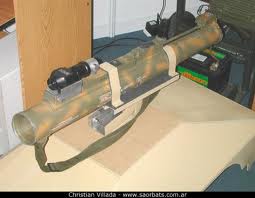
The MARA is a portable one-shot 78 mm unguided anti-tank weapon, designed and manufactured in Argentina by Fabricaciones Militares (DGFM). The solid rocket propulsion unit was developed by CITEFA.
The Precision Shoulder-fired Rocket Launcher-1 also known as the (PSRL-1) is a modified American copy of the Soviet/Russian RPG-7 shoulder-fired rocket-propelled grenade launcher developed by AirTronic USA. The PSRL-1 is primarily manufactured for US-allied nations who are accustomed to Soviet-style weapons and international export.













